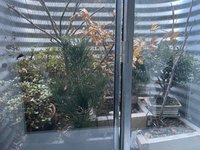Deep Sea Diver
Masterpiece
This is a great discussion folks!
I'm finding there are plenty of nuances that might be better considered when protecting bonsai trees during the winter. Type of tree/cultivar, Sun and WInd exposure, freezing and thawing rate, watering/desiccation and drainage, rate of freezing and unfreezing of the root ball and maybe more. (Then there's damage control for situations like bark splitting and sun scald.)
I've been considering the data I'm measuring from the different locations over time, green house, cold frame, under shelter, exposed, and on the shelf and the implications while diving into the research. First thing I found is the researchers started studying the above ground effects of freezing/cold tolerance.... as studying what happens to the roots only recently. It was too hard as one of the latest review studies mentioned.
The question I first started investigating, how do different forms of protection in different storage locations protect a bonsai tree's roots (stem/branches/buds are a whole another thing) has spawned further questions which I won't bore folks with at the moment.
I'm hoping for another good freeze (sorry Puget Sound folks!) for more data. This present week's data is helping clarify some of the picture. But muddying the waters on other fronts. I will put forward the following, perhaps provoking, statements as food for thought.
Cheers
DSD sends
I'm finding there are plenty of nuances that might be better considered when protecting bonsai trees during the winter. Type of tree/cultivar, Sun and WInd exposure, freezing and thawing rate, watering/desiccation and drainage, rate of freezing and unfreezing of the root ball and maybe more. (Then there's damage control for situations like bark splitting and sun scald.)
I've been considering the data I'm measuring from the different locations over time, green house, cold frame, under shelter, exposed, and on the shelf and the implications while diving into the research. First thing I found is the researchers started studying the above ground effects of freezing/cold tolerance.... as studying what happens to the roots only recently. It was too hard as one of the latest review studies mentioned.
The question I first started investigating, how do different forms of protection in different storage locations protect a bonsai tree's roots (stem/branches/buds are a whole another thing) has spawned further questions which I won't bore folks with at the moment.
I'm hoping for another good freeze (sorry Puget Sound folks!) for more data. This present week's data is helping clarify some of the picture. But muddying the waters on other fronts. I will put forward the following, perhaps provoking, statements as food for thought.
- All species of trees are not created equal in regards to cold hardiness.
- The same tree can have a difference in cold hardiness one winter versus the next... or even in the same winter.... depending upon the weather during paradormancy and the first stage of endodormancy.... and the later on, the weather during endodormancy and ectodormancy.
- Tree roots are not evolved to handle the freezing temperatures and other extremes that trunks/branches/buds were.
- Root damage can be subtle and hard to notice as budding is independent of root growth.... and even microdamage to the growing tips of the roots, where it will start first, will be at the expense of the next year's overall growth making it very hard to acknowledge by a hobbyist.
- A frozen root ball is not the best thing for a tree, especially for extended periods of time. Some trees stems can handle the subsequent loss of water supply from the roots better then others. Especially if stored using layers of protection (see above factors) yet that doesn't mean subtle damage to the trunk, branches and buds isn't occurring over time.
- Measuring the soil temperature under a bonsai pot is not an accurate indication of what is occurring within the media in the pot. The data I gathered showed the media inside a pot with a bonsai tree planted inside placed upon the ground was frozen (put in place 3 weeks before the freeze) while the soil temperature right beside these pots remained 2-3F warmer in each of the three key locations. (cold frame, under shelter, no shelter).... This particular data was taken during a 10 day period Dec/Jan last.
- Putting most trees on the ground is a good first step. Burying them in the ground is better. Cold frame is even better. The data shows none of these locations will protect the bonsai in a pot's root ball from freezing. Even when mulched and covered with snow. None.
- The more "layers of protection" as mentioned above, the more moderation the tree experiences in its journey into, during and when leaving a freeze.
Cheers
DSD sends

